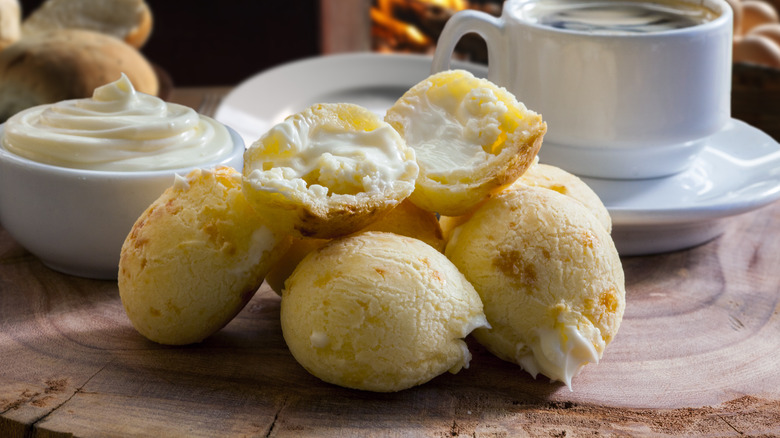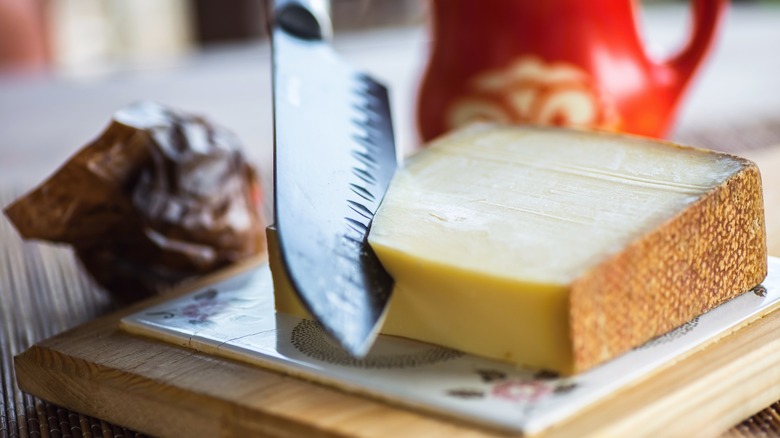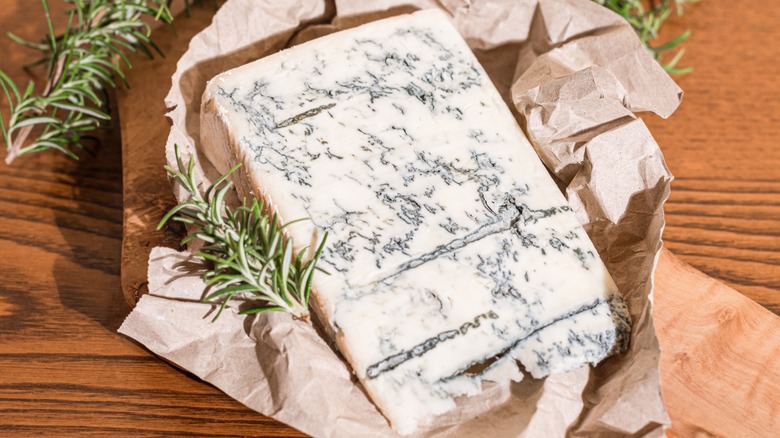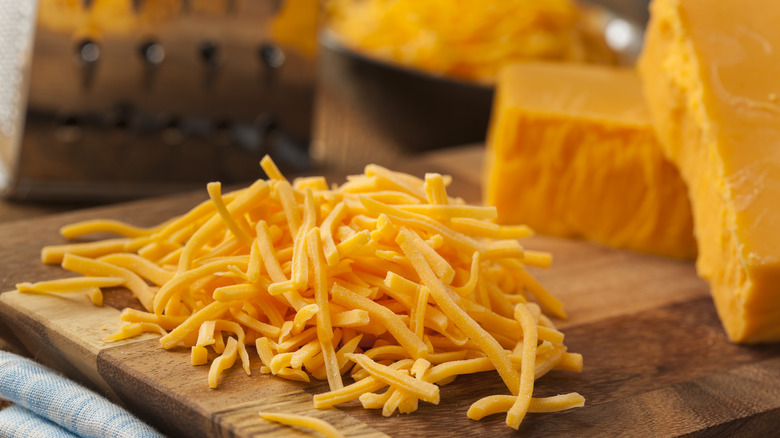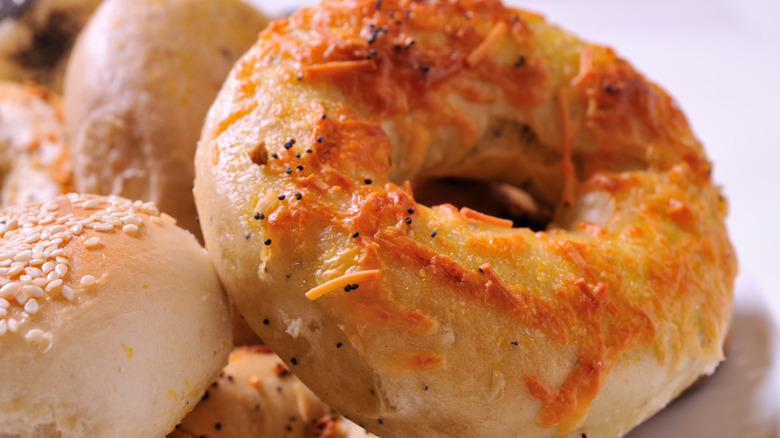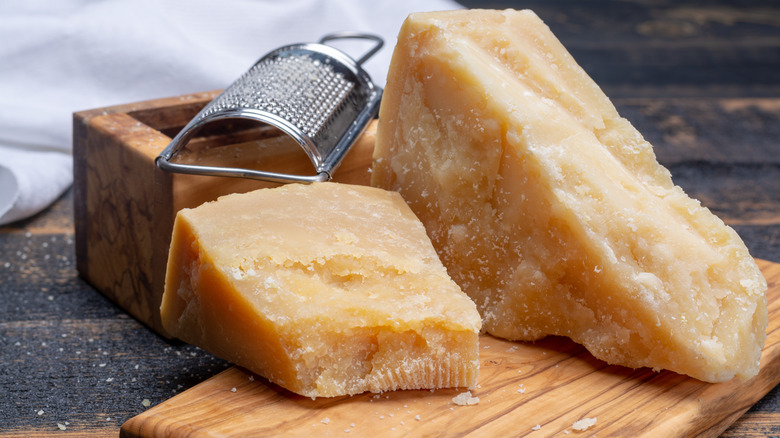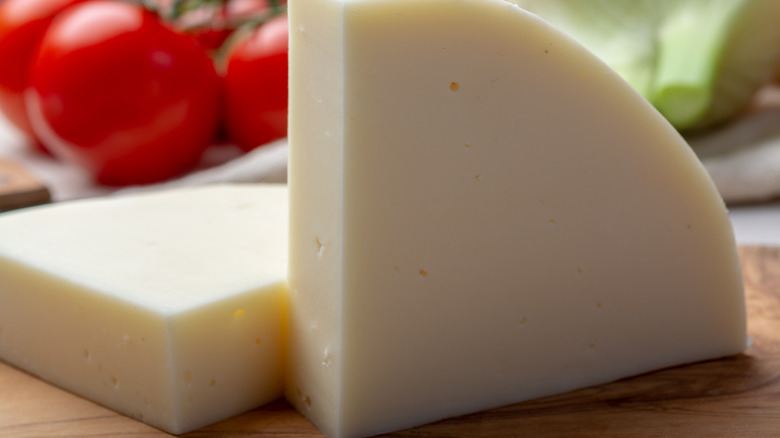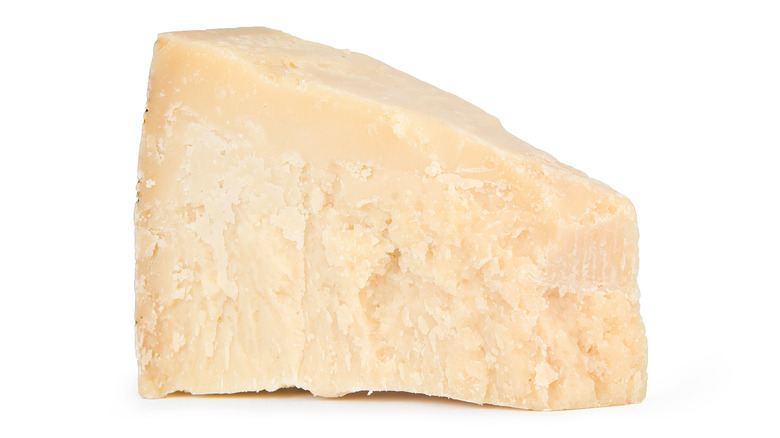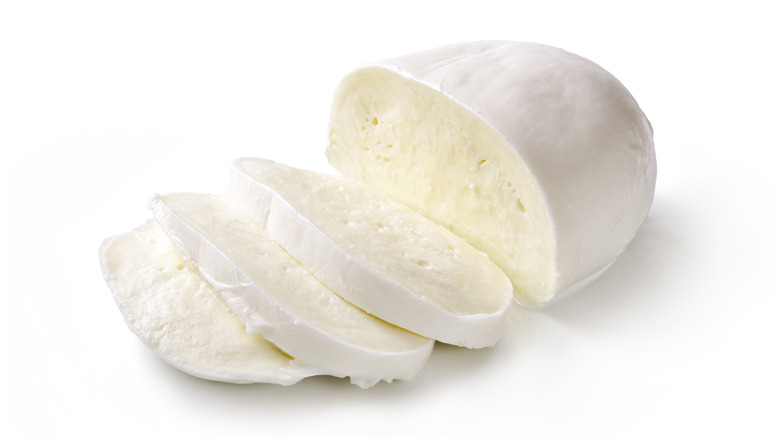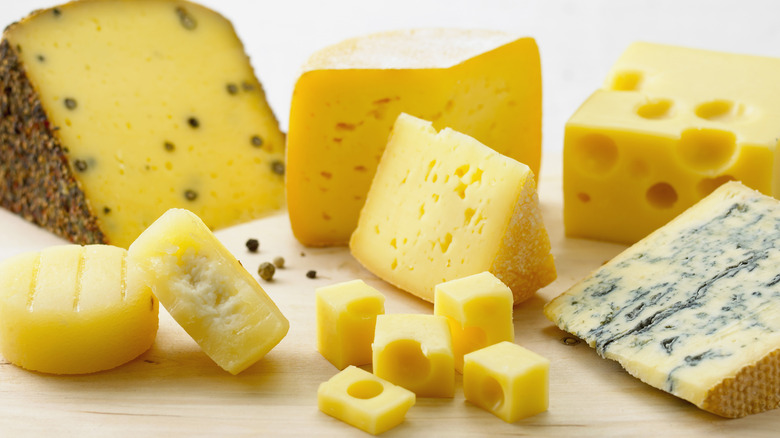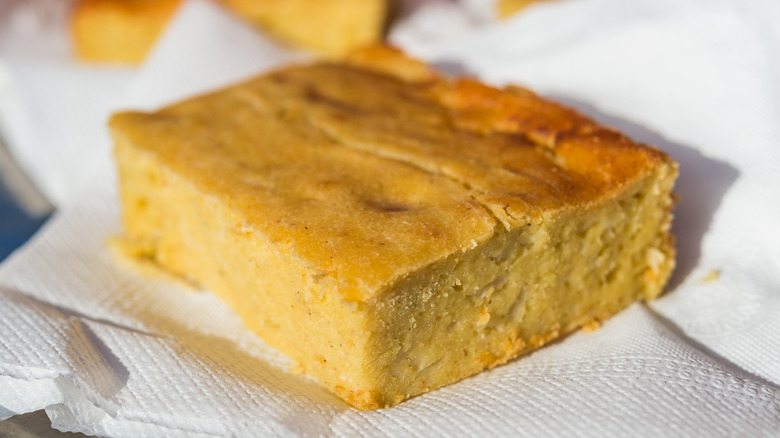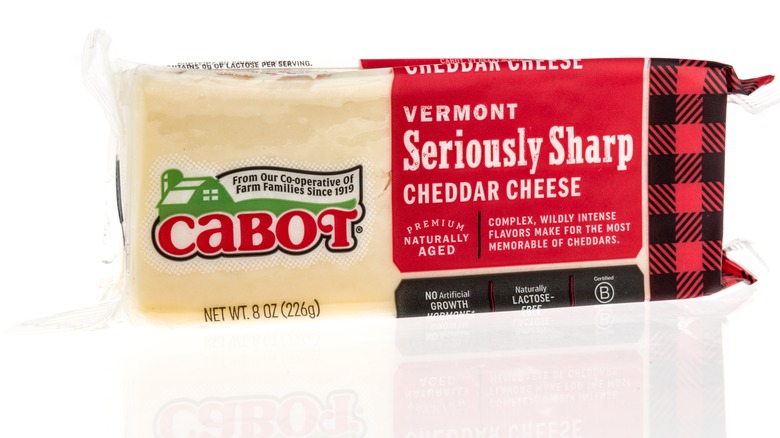11 Absolute Best Types Of Cheese To Use When Baking Bread
Few things make food better like cheese. Can't get your kid to eat their veggies? Douse it with cheese. Need a quick snack after school? Grab a stick of string cheese. Want to take your spaghetti dinner to new heights? A snowfall of Parmesan cheese should do the trick. Heck, how often have you found yourself looking in the fridge for something to eat while spooning mouthfuls of shredded cheese into your mouth? It's just one of those comfort foods that has a way of making anything and (almost) everything better.
That includes bread. Adding a hint of cheese to your baked bread brings an entirely new flavor profile. But what kind of cheese should you reach for? After all, you head down to the deli section of any grocery store and you're bound to find more cheese flavors than cereal flavors. Some of which you might even need some phonetic help with pronouncing complicated names.
Don't worry. We're here to help offer some tips, suggestions, and guidelines for picking out the best types of cheese for your baked bread.
Gruyere
Born in the cheese-loving country of Switzerland, gruyere cheese brings both a salty and sweet taste profile to your baked goods. So whether you're someone that likes to slather a heaping layer of salty butter on top of sliced bread or you're in search of a sweet marmalade, gruyere is the best of both worlds.
However, one thing to keep in mind is the age of the cheese. This kind of cheese is one you're able to age, and, much like wine, it becomes much more complex the older it gets. Younger gruyere (such as one freshly made), is ideal for baking purposes as it is easier to handle. It is softer, which is something you'll want when it comes to baking. Fully-aged gruyere, which can be left to age for up to a year, will have more of a robust and deeper, almost earthy tone to it. That might work if you're looking for a unique dipping sauce for pretzels, and by all means, experiment with your baked goods if you'd like (that's part of the fun), but in general, you'll be better off going with the young, fresh gruyere cheese.
If you're not sure just yet if it is a good fit for your own baking, gruyere it makes for an excellent addition to a grilled cheese sandwich, so feel free to give that a spin before deciding whether or not it is the perfect addition to future baked bread recipes.
Gorgonzola
This is basically an Italian version of blue cheese, which means if you can't find gorgonzola at the local grocery store, or if it's costing more than you'd like, feel free to substitute gorgonzola with blue cheese.
In general, it is a good idea to use a stronger flavored cheese when baking bread, because cheese with mild flavors will disappear into the background of your bread when it's ready to slice. Typically, the entire purpose of adding cheese to your bread is for it to influence the final taste. And of all the cheeses on the list, few kinds of cheese bring this strong of a flavor to bread as marble-like gorgonzola does.
The original gorgonzola is one of the oldest cheeses in the world, dating all the way back to the 11th century. Of course, back then, refrigeration outside of keeping food stored in damp, dark, cellars, wasn't a thing, so foods spoiled faster. Fresh gorgonzola has a softer, creamier taste, while the sharp, nutty flavor intensifies the longer it ages.
Gorgonzola is a crumbled cheese (similar to feta or other kinds of blue cheese), so it's easy to break the cheese down and mix it into your bread recipe. If you're interested in baking a new bread for wine night, this is an excellent option.
Cheddar
The perfect cheese to begin your baking bread-with-cheese journey is cheddar. This is a great place to start as it is readily available, and it is pretty affordable. You might not find a store brand of gorgonzola or gruyere, but you absolutely will find an inexpensive store brand of cheddar.
Cheddar has its origin in England and was first made in, yes, the village of Cheddar. While it isn't as old as many other cheese variations mentioned in this list, it still has a nearly 200-year history. And, despite its relatively youthful age when compared to these other cheeses, it's pretty popular.
You'll want to grab sharp cheddar cheese for your baked-good recipes. As mentioned earlier, mild cheeses will not have as much of a flavor impact on the final baked good as you might like.
If you've made any kind of grilled cheese sandwich before, chances are you used cheddar, so you already have some idea as to what the finished product will taste like. Ideally, you will grab a brick of cheddar instead of the pre-shredded cheese, as pre-shredded cheese often has additional chemicals included to keep it fresh and prevent it from caking together. But whatever you decide to go with, this is a very user-friendly cheese for baking.
Asiago
Do you love grabbing a fresh-baked bagel with your coffee on the way to work? If so, you've probably at least once dabbled in the world of asiago cheese bagels. They have an herbal, zesty taste that brings incredible life to even the plainest of bagels. But asiago has evolved over the years. While the initial rendition of the cheese first emerged in Italy, it didn't take on its current form and come over to the United States until Italian immigrants brought it over following WWI.
Asiago, like many other kinds of cheese, is named for the town of its birth. Hailing from Asiago, Italy, the cheese does share a number of similarities with Parmesan. However, it has more of a buttery, earthy taste to it. This is thanks to the fresh whole cow's milk used in its production. It's the buttery aspect that has made it such a darling in the world of bagel bakers. If you like Parmesan, but find it is a bit on the sweet, almost fruity side for your liking, Asiago is the creamy, slightly bitter cousin of Parmesan, and it's well worth using it in your next loaf of bread.
Who knows, maybe instead of stopping off before work for a toasted asiago bagel, you can save a few bucks and start baking your very own asiago bagels at home.
Parmigiano-Reggiano
If you or someone you're cooking for is lactose intolerant, Parmigiano Reggiano is a fantastic cheese to consider. This is because it is a lactose-free cheese. It comes from Italy and, in order to be considered Parmigiano Reggiano, it must hail from the Parma, Modena, Bologna, Mantua, or Reggio Emilia regions of the country. If you've ever held this cheese up next to Parmesan and wondered what the difference is, it's that one is carefully monitored in Italy, and the other, Parmesan, doesn't have the same kind of specifications or requirements.
When buying Parmigiano Reggiano, you will have a much more consistent taste and texture, regardless of the brand, while Parmesan flavors can be all over the place (due to not having the same consistency requirements). It's also worth noting that while Parmigiano Reggiano is lactose-free, it doesn't necessarily mean Parmesan is as well. Parmesan typically is low in lactose, but it will still contain trace amounts. For anyone with a zero-tolerance lactose issue, it is likely well worth paying the extra money for the Italian cheese if it means they'll be able to enjoy the bread the same as everyone else. And because this cheese is so closely related to Parmesan, you can always swap it in for any particular Parmesan bread recipe you've wanted to try.
Provolone
Provolone is a creamy, smooth cheese that, as is the case with many of the cheeses on this list, comes from Italy. In order to produce the creamy and smooth texture of this cheese, full-fat cow's milk is used. The high level of fat used in the cheese allows the cheese to melt much like butter, which makes it easy to combine into a bread recipe.
Unlike most of the other, more robust cheeses on the list, the taste of provolone cheese is on the mild side. This means it isn't going to dominate the taste of the bread, and in some cases, the taste of the cheese will be minimal at best. Depending on what you're looking for in your finished bread, this can work for a few reasons. First, there might be times when you don't want the cheese to dominate the overall taste of the bread. Perhaps you are using various fresh herbs and spices and you want these flavors to be at the forefront of everyone's tongue. When that's your goal, provolone is perfect. Additionally, it can help add some needed moisture to the bread thanks to the high percentage of fat. Provolone just proves the point that whatever you're looking to achieve, chances are there is a cheese that can help you reach your bread-baking goals.
Parmesan
We touched a bit on Parmesan a bit earlier, and while it is similar to Parmigiano Reggiano, it is important to keep the two separate. There are all kinds of Parmesan cheeses out there, and as there are no set production requirements, the various brands you come by will offer slightly different taste profiles. Parmesan is made not only in Italy, but it is a popular cheese produced in Australia, Argentina, and the United States. Yes, the Parmesan taste from each region will slightly vary. It's why you can buy costly rind Parmesan at the deli section of your grocery store and, at the same time, purchase cheap, store-brand sprinkle Parmesan cheese in a green container that doesn't need to be refrigerated.
Much like cheddar though, there are affordable options out there, proving you don't need to break the bank when baking with cheese. Parmesan is also a common cheese used on breadsticks.
Beyond baking traditional bread with Parmesan, perhaps you are interested in exploring the culinary styles of other regions around the world. If so, many of the nations in South America produce their own, unique, cheese bread (there's another cheese bread from a different country later on the list). In Brazil, you will find a popular cheese bread made with Parmesan known as pā de quijo.
Mozzarella
If it works on pizza, it has to work well on baked bread, right?
Mozzarella is another Southern Italy cheese, although the traditional version of mozzarella is made using Italian buffalo milk and not cow's milk (not that the two are that different, as Italian buffalo is a form of water buffalo, and in the same family as the cow). Of course, unless you're buying mozzarella that clearly states it is made in the south of Italy, chances are it was made using cow's milk.
If you want a cheese that doesn't fully blend into the bread, but instead forms its own pocket of cheese, mozzarella may be the one for you. Because it is low in moisture, it isn't going to fully melt and blend like the higher-fat cheese options out there. It's why you can make a calzone and the mozzarella isn't going to seep into the breading, or why pizza joints around the country can make "stuffed crust" pizza and the cheese in the crust isn't absorbed into the dough.
Keep this in mind when deciding whether or not mozzarella is the right cheese for your baked bread. Do you want beautifully blended cheese bread? Best go with something else. But are you cool with little pockets of string-cheesy goodness? Reach for the mozzarella.
Juustoleipä
Okay, so we're cheating just a little bit with this particular cheese. How? Because you're not actually going to bake this cheese into bread. No, the cheese itself is the "bread." In fact, this mouthful of cheese name is often referred to as bread cheese, because it very much has a crust-like top and bottom, with a gooey, melted, inside. Basically, juustoleipä is the no-bake cheese bread you've been looking for (the name itself is Finish for "bread cheese").
For this entry, we're taking a break from Italian cheeses and heading northwest to Scandinavia. If you'd like to do your best to pronounce it when heading to the deli, juustoleipä is pronounced hoo-stah-lee-pa. The cheese itself has a charred top and bottom that very much gives it the look of toast. In fact, you might fool friends and family at the next gathering into thinking it's bread, when in fact it's actually cheese. The cheese itself is mild with buttery notes. It can be eaten either cold or out of the oven, so the brick slices beautifully.
The country of origin for this cheese will heavily impact the flavor, though. If it is made in the United States it will likely come from cow's milk. However, if you can find a Scandinavian version, it is traditionally made with reindeer milk. So, who knows, it could be a fun little cheesy treat when gearing up for the winter holidays.
Paraguay cheese
When it comes to culinary bigwigs, Paraguay likely isn't at the top of your list. This country has a number of interesting foods going for it, one of which is Paraguay cheese. Unlike Italy, which seemingly has a cheese named for every city, town, and village in the country, Paraguay has focused most of its dairy efforts on its flagship, Paraguay cheese.
This is a soft, acidic white cheese. If you go to the deli, ask for Paraguay cheese, and the person behind the counter has a blank look on their face as if you just made up the cheese, don't worry, you can replace it with feta, muenster, or white cheddar. The tastes are different, but there are enough similarities to come close to what Paraguay cheese delivers. Paraguay cheese, as well as the substitutes, blend nicely with your baked bread, as the creamy cheese will melt. So instead of ending up with chunks of cheese, it will integrate throughout the baked good.
Much like Brazil, Paraguay has its own unique cheese bread. The Paraguayan version is known as sopa, which is similar to an American cornbread. The difference here is that sopa isn't as sweet as cornbread, and the inclusion of the cheese gives just a hint of dairy creaminess while enhancing the moisture of the bread. Shaved white onion is also included, essentially turning the side dish of cornbread into its own meal (dipping into chili is not required).
Vermont sharp cheese
Vermont sharp cheese can fall under the classification of a sharp white cheddar, and yet it has subtle nuances that separate it and give it a more rounded taste. Most cheese hailing from Vermont doesn't come from the massive dairy farms, and many of these farms have been producing cheese since before the industrial revolution.
Vermont sharp cheese has an intense, bitter cheddar taste. Think of it as a traditional sharp cheddar turned up a notch. This is because the cheese has a higher sulfur tone to it than other cheddar cheese on the market. Much of this is actually due to the natural mineral makeup found in Vermont's water as compared to, say, Wisconsin. The water is then passed into the grass, and dairy cows both drink the water and eat the grass. That mineral profile affects the milk produced by the cows, and eventually the cheese made from the milk.
Due to the strong flavor of this cheese, it is fantastic to use in baking bread, because it really does take center stage. However, if you haven't had Vermont sharp before, it's highly suggested to taste-test it first. If you grew up on one kind of cheddar cheese, have had it for years, and then try one that has a stronger, more bitter taste, it can take you by surprise.
